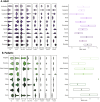White matter diffusion estimates in obsessive-compulsive disorder across 1653 individuals: machine learning findings from the ENIGMA OCD Working Group
- PMID: 38326559
- PMCID: PMC11176060
- DOI: 10.1038/s41380-023-02392-6
White matter diffusion estimates in obsessive-compulsive disorder across 1653 individuals: machine learning findings from the ENIGMA OCD Working Group
Erratum in
-
Correction: White matter diffusion estimates in obsessive-compulsive disorder across 1653 individuals: machine learning findings from the ENIGMA OCD Working Group.Mol Psychiatry. 2024 Apr;29(4):1216. doi: 10.1038/s41380-024-02494-9. Mol Psychiatry. 2024. PMID: 38454086 Free PMC article. No abstract available.
Abstract
White matter pathways, typically studied with diffusion tensor imaging (DTI), have been implicated in the neurobiology of obsessive-compulsive disorder (OCD). However, due to limited sample sizes and the predominance of single-site studies, the generalizability of OCD classification based on diffusion white matter estimates remains unclear. Here, we tested classification accuracy using the largest OCD DTI dataset to date, involving 1336 adult participants (690 OCD patients and 646 healthy controls) and 317 pediatric participants (175 OCD patients and 142 healthy controls) from 18 international sites within the ENIGMA OCD Working Group. We used an automatic machine learning pipeline (with feature engineering and selection, and model optimization) and examined the cross-site generalizability of the OCD classification models using leave-one-site-out cross-validation. Our models showed low-to-moderate accuracy in classifying (1) "OCD vs. healthy controls" (Adults, receiver operator characteristic-area under the curve = 57.19 ± 3.47 in the replication set; Children, 59.8 ± 7.39), (2) "unmedicated OCD vs. healthy controls" (Adults, 62.67 ± 3.84; Children, 48.51 ± 10.14), and (3) "medicated OCD vs. unmedicated OCD" (Adults, 76.72 ± 3.97; Children, 72.45 ± 8.87). There was significant site variability in model performance (cross-validated ROC AUC ranges 51.6-79.1 in adults; 35.9-63.2 in children). Machine learning interpretation showed that diffusivity measures of the corpus callosum, internal capsule, and posterior thalamic radiation contributed to the classification of OCD from HC. The classification performance appeared greater than the model trained on grey matter morphometry in the prior ENIGMA OCD study (our study includes subsamples from the morphometry study). Taken together, this study points to the meaningful multivariate patterns of white matter features relevant to the neurobiology of OCD, but with low-to-moderate classification accuracy. The OCD classification performance may be constrained by site variability and medication effects on the white matter integrity, indicating room for improvement for future research.
© 2024. The Author(s).
Conflict of interest statement
The authors declare no competing interests.
Figures





References
MeSH terms
Grants and funding
- P41 EB015922/EB/NIBIB NIH HHS/United States
- K01 MH122774/MH/NIMH NIH HHS/United States
- 22H01090, 19K03309/MEXT | Japan Society for the Promotion of Science (JSPS)
- UL1 TR001863/TR/NCATS NIH HHS/United States
- JP22dm0307008/Japan Agency for Medical Research and Development (AMED)
- R01 MH116147/MH/NIMH NIH HHS/United States
- K24 MH121571/MH/NIMH NIH HHS/United States
- K24MH121571/U.S. Department of Health & Human Services | NIH | National Institute of Mental Health (NIMH)
- WT_/Wellcome Trust/United Kingdom
- JP22dm0307002/Japan Agency for Medical Research and Development (AMED)
- K23 MH115206/MH/NIMH NIH HHS/United States
LinkOut - more resources
Full Text Sources
Medical
Miscellaneous

